All our Dyfi ospreys have migrated
Berthyn held on until she was 101 days old, the first Dyfi offspring to make it past 100 days old before migrating.
All our Dyfi ospreys have migrated
Berthyn held on until she was 101 days old, the first Dyfi offspring to make it past 100 days old before migrating.
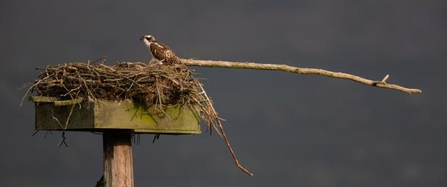
Berthyn. © MWT
After some autumnal windy weather in early September, a perfect high pressure migration window opened up on Thursday last week and Berthyn took full advantage of it. A couple of hours later Monty also left.
Monty stayed until his final offspring had gone
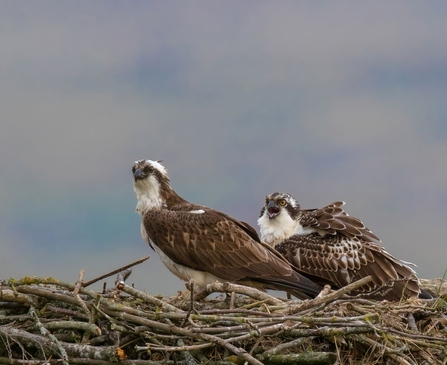
Monty (left), Berthyn. © MWT
Here are the 2019 migration dates of all the Dyfi birds:
Telyn: 23rd August at 18:26
Peris: 23rd August at 17:03
Hesgyn: 25th August 16:32
Berthyn: 5th September at 07:20
Monty: 5th September at 09:32
Here's how Berthyn and her two brothers, Peris and Hesgyn, fit into the overall Dyfi migration chart:
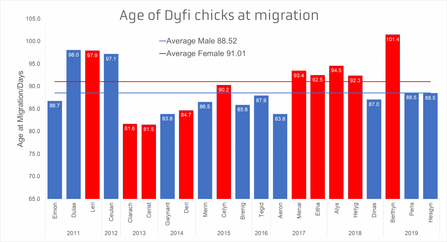
The two boys were bang-on average and, coincidentally, both migrated at the exact same age - 88.5 days old.
The usual caveat applies here - these are the last times we saw the birds, so the minimum ages they will have gone.
And for the statistically adventurous, here is a chart showing the differences in ages of Nora's-Glesni's-Telyn's chicks:
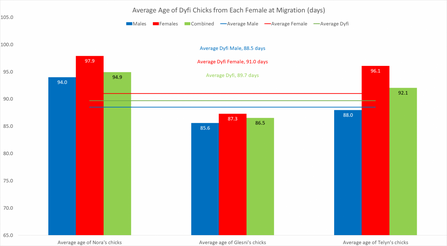
Glesni's chicks are the youngest to migrate on average and by quite a margin. The fact that this year we saw Aeron return completes a full-house of Glesni's five years at the Dyfi. One bird from each breeding year has returned as an adult - an amazing achievement that illustrates her fantastic maternal skills.
And again, these are just the birds we know about of course; almost certainly there will be more offspring out there - especially the females.
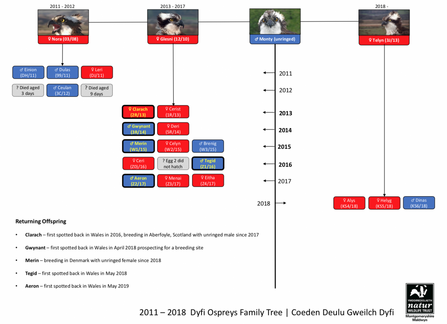
If you missed Aeron's return earlier this summer - here is the video:
© MWT
Clarach unfortunately had a failed breeding attempt at her Scottish nest - foiled again by predation.
For the first time in several centuries, Wales had five breeding nests this year.
The ON4 Snowdonia pair returned after abandoning their nest in 2018 and Blue 24 returned to her Llyn Brenig platform making a total of five productive Welsh nests for the first time.
The upside of having a recovering population is that average osprey colony productivity in the early years is always higher than that in more normalised populations. This is true of most living things whether you're an orchid, a dung beetle or an osprey. Population growth rates are correlated directly with what we call ecological density dependence: the less competition for food, mates, breeding sites and less predation pressures, the more successful breeding (productivity) is on average.
Here are some woodpeckers to demonstrate:
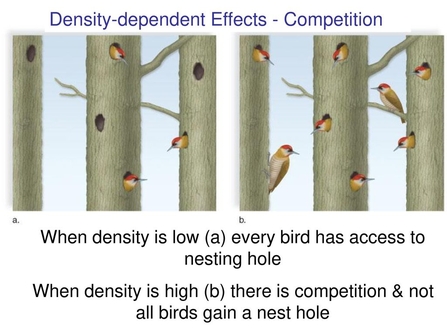
Disturbance also has an effect on breeding success, whether from other ospreys or humans.
It's no coincidence that again this year the three Welsh nests that experienced the least disturbance produced the most chicks. The Glaslyn, Dyfi and Clywedog nests all produced three eggs and three chicks.
The productivity of a bird's nest can be expressed in several ways, I have therefore produced the table below to show the various stages of the breeding season, the bottom-line being that 10 Welsh osprey chicks survived to migration age.
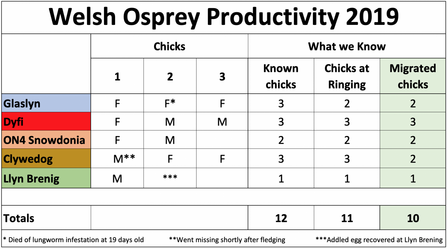
Sadly one of the Glaslyn chicks died of lungworm and we think that Clywedog's oldest chick went missing shortly after fledging. An addled egg was recovered at Llyn Brenig during ringing, but we'll never know whether early reports of two chicks in the nest were accurate.
By the time Tony got to the nest at four to five weeks after hatching to ring the clutch, there was only one chick in the nest, a male that Welsh Water/Dŵr Cymru called 'Roli'.
Unhatched egg retrieved at Llyn Brenig during ringing
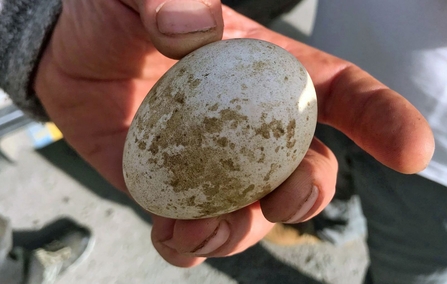
No matter which measure you choose to represent breeding success, Wales had a productivity of at least 2.0 (10 migrating birds from five nests). This is double the productivity rate of an established colony operating at full density dependency saturation - a direct result of a low (recovering) population density I mentioned above. Every cloud etc..
Next week we will design the 2020 DOP calendar and send it to the printers, we have some cracking photos from this year. We hope to have the online shop open for early October as usual.
We will also have a brand new pin badge on sale - Telyn.
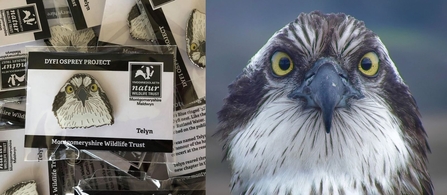
Alwyn and Thom have also migrated for the winter - they will be back next year at the same time as the ospreys. I won't mention their migration ages.
That leaves Kim, Janine and myself - we will now be working full time on the Dyfi Wildlife Centre until next spring. Construction work has already started and beginning tomorrow we will bring you a new series: 50 Short Stories. Each Short Story will be published on this website (under blogs), on DOP Facebook and Twitter.
Highly advanced lay-line measuring equipment
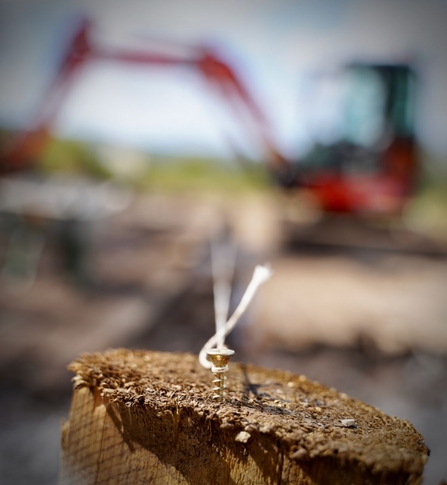
Each Short Story will focus on one aspect of the building and will include an explanation of what is happening and why - at that particular time.
It will also be an opportunity for you to ask questions and keep up to date on the building's progress. We'll do our best to answer all your questions. We will include either a quality photo(s) or video with each Short Story so that you can hopefully see how we've taken on board many of your comments and suggestions over the last two years (remember the Survey Monkey questionnaire you did in January 2018?) and applied them to the new centre.
We warmly welcome you on our winter journey with us, it should be fun.
Out with the old... the 'visitor centre' is removed and upcycled into the Dyfi Wildlife Centre builders' 'new' rest cabin
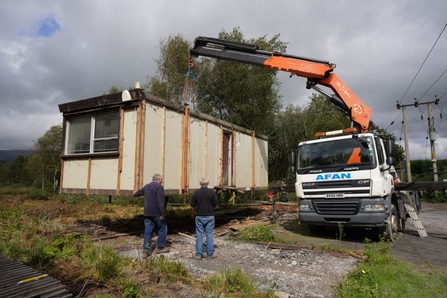
Appeal
Our Dyfi Wildlife Centre Appeal is going well. Just over 12 months ago needed £250,000 but this is now down to around £65,000.
If you've enjoyed the season with us, would you mind donating to the appeal please?
Many thanks.
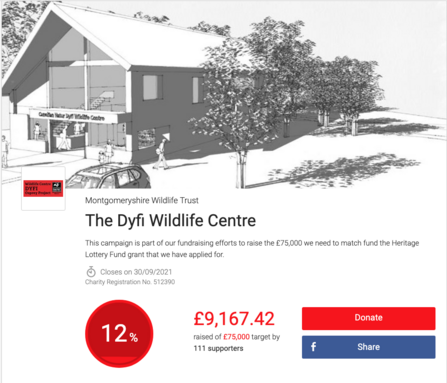
And Finally...
We closed DOP for the last time in its current format a couple of weeks ago on 30th August.
I was sitting with a volunteer in the visitor centre feeling all nostalgic on that final Friday afternoon when a visitor came in and politely asked us..."Why is it that people keep coming back to DOP year after year... after all, once you've seen the ospreys that's it, isn't it?"
I thought about it for a while and with a one-word answer and a smile, replied: "Compassion".
Compassion for our ospreys, our environment, our volunteers, our visitors and followers.
If you live in the UK you'll know that our political system has, by now, degenerated into a full-blown circus; clowns to the left, right and everywhere you look. Individuals purporting to represent the truth and the 'will of the people', others attacking them for not.
DOP is free from politics and religion. A safe-house where everybody is welcome and nobody is excluded. It's a place of sanctuary and compassion where thousands of people each year can dip into, briefly if they want, and hide away from the craziness happening around them free from 'fake news' and 'alternative facts'.
We lost three remarkable people this summer that gave so much to DOP over the years, volunteers Carol Swales and Brayton Holt... and Donald Evans - my Dad.
DOP and its people meant the world to them. We need more compassion in the world, life is too short to be angry.
This year's end-of-season video is dedicated to these three compassionate individuals.
Beautiful people, beautiful birds, beautiful pictures.
© MWT